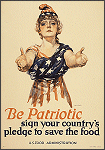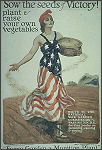
Sow the Seeds of Victory! Posters from the Food Administration During World War I
Background
Even in peaceful times Americans frequently debate fundamental questions about government: What should the federal government do? What does the Constitution sanction? What does it prohibit? What is the relationship between governmental action and volunteerism? During wars, declared or not, Americans argue even more fervently as they often witness government undertaking different and more numerous roles than it undertakes during peacetime.
From the outbreak of World War I in Europe until the signing of the Versailles Treaty, the Wilson administration proposed and implemented an extraordinary number of programs that affected the lives of Americans in their everyday activities. Even the Progressives, who tended to favor more state and federal responsibility, must have been dazed at the expansion of government action beyond the conventional arenas of public policy.
The Lever Act of 1917 represents both the normal working of American government and the extraordinary circumstances of World War I. The process of creating the Lever Act certainly followed the "legislative dance" outlined in the Constitution and congressional custom. Entries in the indexes to the New York Times for 1917 testify to the accepted but various interests of members of Congress in supporting or opposing the legislation; other entries show the range of lobbyists interested in supporting or opposing the bill. In this, the legislative dance seemed typically American: proposed legislation, support or opposition from special interest groups, legislative revision, and congressional hearings. In August 1917, the dance ended. Congress passed the Food and Fuel Control Act (40 Stat. 276), also known as the Lever Act.
Passage of the bill did not immediately impact the American public. Like any federal legislation, the Food and Fuel Control Act faced the next normal step: implementation, the stage of policy- making between the establishment of a policy and the consequences of the policy for the people it affects. With the authority and power granted to him by Congress in the legislation, on August 10, 1917, President Woodrow Wilson issued Executive Order 2679-A creating the U. S. Food Administration. In doing so, he created a government entity to replace an existing volunteer organization. The U. S. Food Administration, operating in each state, was to
- Assure the supply, distribution, and conservation of food during the war,
- Facilitate transportation of food and prevent monopolies and hoarding, and
- Maintain governmental power over foods by using voluntary agreements and a licensing system.
Using the same authority, Wilson created two subsidiaries, the U. S. Grain Corporation and the U. S. Sugar Equalization Board. Together these bodies would extraordinarily impact American lives.
Herbert Hoover, former head of the Belgian Relief Organization, lobbied for and won the job of administrator of the Food Administration. Hoover had made clear to President Wilson that a single, authoritative administrator should head the effort, not a board. This, he believed, would ensure an effective federal organization. He further insisted that he accept no salary. Taking no pay, he argued, would give him the moral authority he needed to ask the American people to sacrifice to support the war effort. As he later wrote in his memoirs, his job was to ask people to "Go back to simple food, simple clothes, simple pleasures. Pray hard, work hard, sleep hard and play hard. Do it all courageously and cheerfully."
As head of the U. S. Food Administration, Hoover, given the authority by Wilson, became a "food dictator." The Lever Act had given the president power to regulate the distribution, export, import, purchase, and storage of food. Wilson passed that power on to Hoover. To succeed, Hoover designed an effort that would appeal to the American sense of volunteerism and avoid coercion. In designing the program, he adopted a federal approach, combining centralized power and decentralized power. He oversaw federal corporations and national trade associations; he sought cooperation of local buyers and sellers. Through it all he called for patriotism and sacrifices that would increase production and decrease food consumption. "Food," Hoover and the administration proclaimed, "will win the war."
"No aspect of the people's lives remained unchanged," wrote one historian in assessing the effect of this board and its companions, the War Industries Board and the Fuel Administration. Under Hoover's direction, the Food Administration, in league with the Council of Defense, urged all homeowners to sign pledge cards that testified to their efforts to conserve food. The government boards issued the appeal on a Friday. By the following week, Americans had embraced wheatless Mondays, meatless Tuesdays, porkless Saturdays. According to a sesquicentennial article in the Milwaukee Journal Sentinel, in Wisconsin's Green Lake County 100 percent of the housewives signed on and 80 percent of Milwaukee did. Schoolchildren joined housewives in supporting the effort by signing this pledge: "At table I'll not leave a scrap of food upon my plate. And I'll not eat between meals But for supper time I'll wait." In support of the war effort, Americans discovered nouveau menus filled with dogfish, sugarless candy, whale meat, and horse steaks. They planted victory gardens and prized leftovers. Even President Wilson cooperated, grazing sheep on the White House lawns. The emphasis on voluntary support worked.
While Hoover preferred the emphasis on the "spirit of self sacrifice," he also had authority to coerce. He set wheat prices, bought and distributed wheat. Coercion plus volunteerism produced results. By 1918 the United States was exporting three times as much breadstuffs, meat, and sugar as it had prior to the war.
To achieve the results, the Food Administration combined an emphasis on patriotism with the lure of advertising created by its own Advertising Section. This section produced a wealth of posters for both outdoor and indoor display. One proclaimed: "Food is Ammunition-Don't waste it." Another featured a woman clothed in stars and stripes reaching out to embrace the message: "Be Patriotic sign your country's pledge to save the food." A third combined patriotism with a modern healthy diet message. At the top, the poster encouraged readers to: "Eat more corn, oats and rye products-fish and poultry-fruits, vegetables and potatoes, baked, boiled and broiled foods." At the bottom, the poster concluded "Eat less wheat, meat, sugar and fats to save for the army and our allies." All of these posters, now part of Record Group 4, the Records of the U. S. Food Administration, testify to the intent of the government to mobilize the food effort during World War I. As much as possible, it did so under a banner of volunteerism, rather than coercion. In doing so, the Wilson administration created a program that did affect the everyday lives of Americans during World War I.
An executive order of August 21, 1920, terminated the remaining branches of the U.S. Food Administration.
Resources
Elle, Kenneth. Herbert Hoover. Boston: Twayne, 1980.
Fausold, Martin L. The Presidency of Herbert Hoover. University of Kansas Press, 1985.
Heckscher, August. Woodrow Wilson: A Biography. New York: Scribner's, 1991.
The Documents
National Archives and Records Administration
Records of the U. S. Food Administration
Record Group 4
National Archives Identifier:
512497
National Archives and Records Administration
Records of the U. S. Food Administration
Record Group 4
National Archives Identifier:
512499
National Archives and Records Administration
Records of the U. S. Food Administration
Record Group 4
National Archives Identifier:
512498
National Archives and Records Administration
Records of the U. S. Food Administration
Record Group 4
National Archives Identifier:
512500



